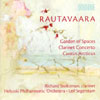Rautavaara Cantus Arcticus; Clarinet Concerto; Garden of Spaces
A beautifully performed programme of two premieres and an old favourite
View record and artist detailsRecord and Artist Details
Composer or Director: Einojuhani Rautavaara
Genre:
Orchestral
Label: Ondine
Magazine Review Date: 11/2005
Media Format: CD or Download
Media Runtime: 59
Mastering:
Stereo
DDD
Catalogue Number: ODE1041-2

Tracks:
| Composition | Artist Credit |
|---|---|
| Cantus arcticus (Concerto for Birds and Orchestra) |
Einojuhani Rautavaara, Composer
Einojuhani Rautavaara, Composer Helsinki Philharmonic Orchestra Leif Segerstam, Conductor |
| Garden of Spaces |
Einojuhani Rautavaara, Composer
Einojuhani Rautavaara, Composer Helsinki Philharmonic Orchestra Leif Segerstam, Conductor |
| Concerto for Clarinet and Orchestra |
Einojuhani Rautavaara, Composer
Einojuhani Rautavaara, Composer Helsinki Philharmonic Orchestra Leif Segerstam, Conductor Richard Stoltzman, Clarinet |
Author: Guy Rickards
First a word about Cantus arcticus, Rautavaara’s most-recorded work after The Fiddlers. The second version Ondine have released – unusually, it concludes the disc – is clearly superior to the earlier Leipzig version (once available on RCA Catalyst – nla). The balance is much better, equal to more recent rivals on BIS and Naxos; indeed, the sound throughout is first-rate, revealing orchestral detail not often heard. Segerstam’s slightly reverential performance is nothing if not entrancing.
For those for whom this work is key, couplings will be all-important. Pommer included Symphonies Nos 4 and 5; Lintu trumped this with the First Piano Concerto and the pseudo-Brucknerian Third Symphony; Vänskä coupled the Seventh Symphony, Angel of Light. Ondine here takes a different tack, providing the premiere recordings of the 2001 Clarinet Concerto and Garden of Spaces (1971, rev. 2003). The Concerto was written for the soloist here, Richard Stoltzman, who has been busily performing it widely; his performance reaps considerable benefit from his intimate knowledge of the work. Rautavaara consulted him during its composition as well, so the instrumental writing is idiomatic as well as challenging. The three movements are by turn dramatic, lyrical and vivacious, although the slightly ambiguous conclusion offers no easy resolutions.
Garden of Spaces is (just) the earliest work here, predating Cantus arcticus by a year. Written for the composer himself to conduct, Rautavaara designed it so that each performance would be different. The fabric of the work falls into units (each with its own orchestral group) that fit together in a mosaic, the pattern of which is for the conductor to determine. This aleatoric approach allows not just the sequence of the units to vary but also for them to be overlaid, dependent on the conductor’s design. Segerstam proves an ideal executant, fashioning a fascinating personal result that is still pure Rautavaara.
For those for whom this work is key, couplings will be all-important. Pommer included Symphonies Nos 4 and 5; Lintu trumped this with the First Piano Concerto and the pseudo-Brucknerian Third Symphony; Vänskä coupled the Seventh Symphony, Angel of Light. Ondine here takes a different tack, providing the premiere recordings of the 2001 Clarinet Concerto and Garden of Spaces (1971, rev. 2003). The Concerto was written for the soloist here, Richard Stoltzman, who has been busily performing it widely; his performance reaps considerable benefit from his intimate knowledge of the work. Rautavaara consulted him during its composition as well, so the instrumental writing is idiomatic as well as challenging. The three movements are by turn dramatic, lyrical and vivacious, although the slightly ambiguous conclusion offers no easy resolutions.
Garden of Spaces is (just) the earliest work here, predating Cantus arcticus by a year. Written for the composer himself to conduct, Rautavaara designed it so that each performance would be different. The fabric of the work falls into units (each with its own orchestral group) that fit together in a mosaic, the pattern of which is for the conductor to determine. This aleatoric approach allows not just the sequence of the units to vary but also for them to be overlaid, dependent on the conductor’s design. Segerstam proves an ideal executant, fashioning a fascinating personal result that is still pure Rautavaara.
Discover the world's largest classical music catalogue with Presto Music.

Gramophone Digital Club
- Digital Edition
- Digital Archive
- Reviews Database
- Full website access
From £8.75 / month
Subscribe
Gramophone Full Club
- Print Edition
- Digital Edition
- Digital Archive
- Reviews Database
- Full website access
From £11.00 / month
Subscribe
If you are a library, university or other organisation that would be interested in an institutional subscription to Gramophone please click here for further information.




